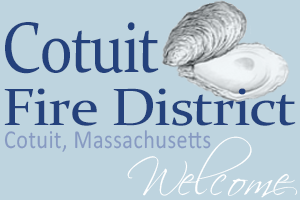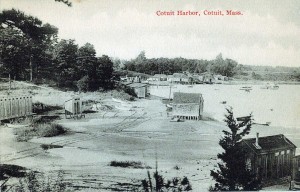Early Years
The history of Cotuit is closely tied to the colonial and maritime history of our region. Cotuit proudly counts early settlers, maritime seafarers, artists, intellectuals, inventors, businessmen (and women) among its citizenry.
Cotuit was part of a land purchase of approximately 20 square miles by Myles Standish in 1648. Standish bought the land from local the Wampanoag Indian leader Paupmunnuck. The negotiated price was a “great brass kettle seven spans around and one broad hoe.” (Editor’s note: This currency, a kettle and a hoe, are the basis for the name of the local Cape Cod Baseball league team “Cotuit Kettleers” and a very popular local restaurant “Kettle-Ho”). The name “Cotuit” is a Wampanoag Indian word meaning “place of the council.” Cotuit was called Cotuit Port until local postmaster Charles Bearse dropped the “Port” in 1872.
The Colonial settlers mainly harvested the bounty of the area: salt marsh hay and oysters. Several small shipyards served to bring the harvest out and connect Cotuit with the rest of the Cape and beyond. Abel Makepeace started the large-scale farming and harvesting of cranberries, and founded the Ocean Spray cooperative. Cotuit grew slowly over the years up through the Civil War.
After the Civil War, Cotuit was discovered by people who appreciated the warm salt water, the miles of pine forest, the abundant sea food, sailing, and quiet location. Hotels such as The Santuit House (1860), The Pines (circa 1890), The Cotuit Inn (circa 1890) served guests from Boston and beyond. Cotuit was once called “The Summer Harvard” as Abbott Lawrence Lowell, President of Harvard from 1909-1932, summered here, attracting other intellectuals, artists, and musicians.
During World War II, Cotuit played a unique role in the war efforts. A training camp, Camp Candoit, base for the 594th Engineer Boat and Shore Regiment, a branch of the 4th Engineer Special Brigade, was located along North Bay. Soldiers practiced amphibious landings, critical skills for landings throughout the Pacific. The army also experimented with survival training with soldiers. Sister camps, Camp Havedonit (Osterville) and Camp Washburn (Falmouth) also provided training. The beaches were paved with asphalt and piers were built for the training. While we won the war, the oyster beds were all but destroyed. It took decades of dedicated work to bring back the world-famous Cotuit oysters.
Today Cotuit has a year-round population of about 2600. An additional 1600 people join us every summer. Some come for a few days, others have come and stayed all summer for decades. Summertime means the annual Fourth of July parade, racing Cotuit skiffs in the bay, clamming and fishing, and catching up with neighbors at the post office. Kids take their bikes down and get an ice cream at “The Coop”; their parents grab a beer at the Kettle-ho.
Historical Society Cotuit Papers
We are fortunate to have a group of citizens who have taken the time to document life in our village. There are several entertaining stories about life in Cotuit. And a big thanks to Fran Parks who shared her collection of Cotuit images to illustrate.
Read the stories. They have been transcribed exactly as found. There are some spelling and grammar conventions that have changed. We chose to present them in their original unedited form.



